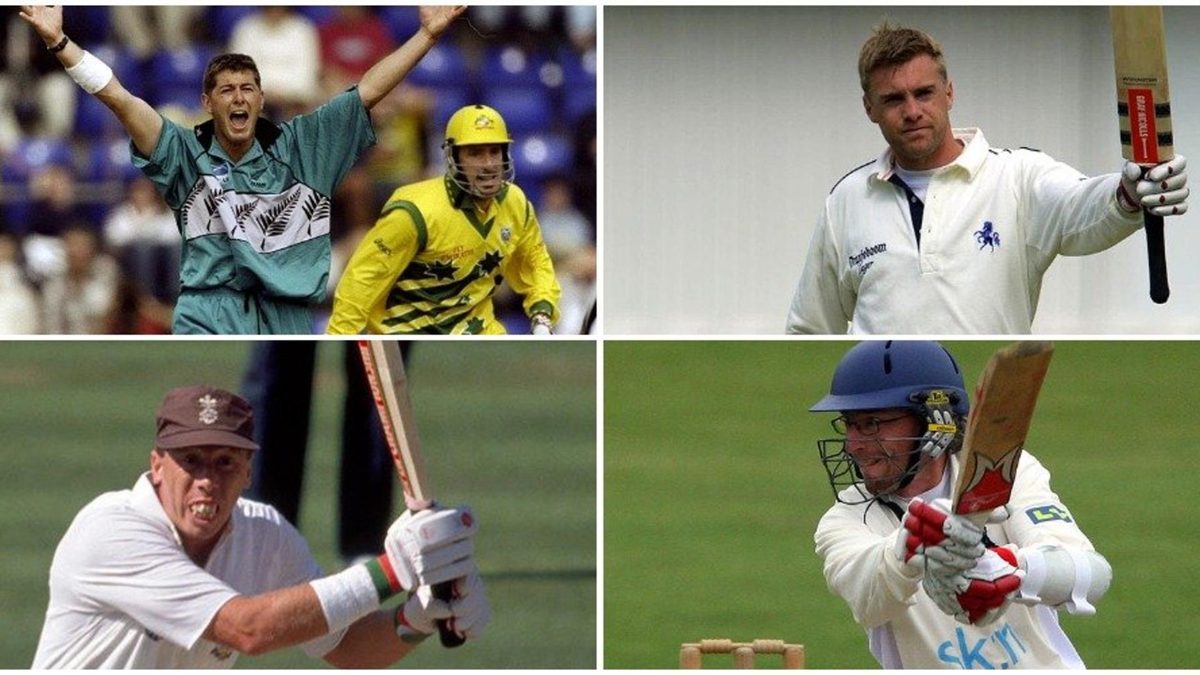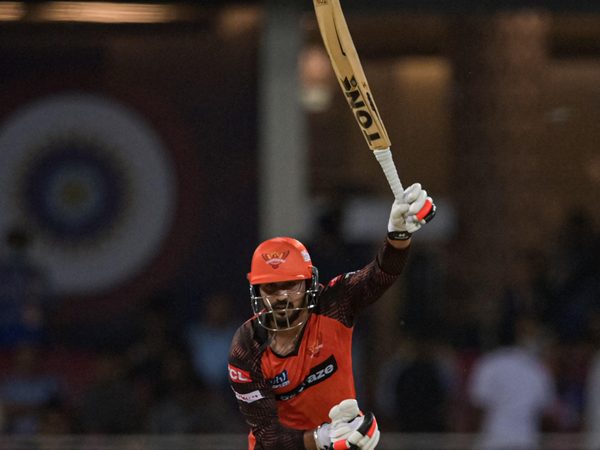
On the latest episode of the Wisden Cricket Weekly Podcast, Wisden.com managing editor Ben Gardner was joined by the Wisden Cricket Monthly trio of editor-in-chief Phil Walker, magazine editor Jo Harman and staff writer James Wallace.
Inspired by new IPL cult hero Rahul Tewatia, the panel put together a “season in the sun” XI – a side containing talents who came out of nowhere to shine for a brief moment in time.
Dave Fulton – Kent, 2001 county season
Jo Harman: “His career was not going anywhere particularly fast, apart from possibly ending. After making his first-class debut in 1992, he’d scored nine [seven] hundreds in 11 [nine] seasons. Then 2001 comes along and he scores nine in the season. It was the final year of his contract too. His career looked like it could be disappearing quite quickly, and then that summer, he was very nearly picked for the Headingley Ashes Test.
“It’s perhaps a little unfair to have him in this team because he did have other seasons where he scored over 1,000 runs, but it was this one season, 2001, where he scored 1,892 runs at 76, nine hundreds in there – Fulton goes from almost losing his county contract to being on the verge of the England Test team.”
Chris Broad – England, 1986/87 Ashes
Phil Walker: “Big-bottomed left-hander who was briefly electric for England in the ’86/87 Ashes. He made three hundreds. He made four hundreds in six games against Australia, made six hundreds in all from 25 Test matches and yet that was the extent of his England career. He was the International Cricketer of the Year at the end of that Australian tour.”
Gautam Gambhir – India, 2008 to 2009 in Test cricket
Ben Gardner: “When you get to that Test career, in isolation – he got nine hundreds – but seven of those came in a 13-month stretch between October 2008 and November 2009. At that point, he rose to No.1 in the world [Test batting rankings]. You kind of think that India, alongside [Virender] Sehwag, have an absolute world-beater here.
“But it just didn’t really happen from then on. He got one more hundred and was torn apart by [Geoffrey] Boycott when he was recalled by India [against England] in 2014.”
David Ward – Surrey, 1990 county season
James Wallace: “Jo, I came across your article about ‘The Year of the Bat’, in 1990, and that’s the year Ward scored over 2,000 first-class runs, including seven tons.
“At the end of Jo’s piece, he [Ward] says: “The first game of the following season I asked Stewie [Alec Stewart] what number I was batting and he said No.6. I said, ‘I’ve just got 2,000 runs last year’. ‘That was last year,’ he replied. Normal service resumed.”
Paul Valthaty – Kings XI Punjab, 2011 IPL
BG: “He did play for India under-19s in the early 2000s, but when the IPL came along he didn’t really get a gig. He didn’t play his first IPL game until 2009. But all of a sudden in the 2011 IPL, basically unknown, opening the batting, he smashes 120 off 63 balls against Ravi Ashwin, [Albie] Morkel and Tim Southee to single-handedly win Punjab a game. Next game, still opening, he smashed 75 off 47 and then that was basically it. He got one more 50 that season, none in 2012, and was dropped in 2013. He hasn’t played in the IPL since.”
Rahul Tewatia – Rajasthan Royals, 2020 IPL
BG: “Coming into the IPL with no real pedigree behind him, [Tewatia] has won Rajasthan Royals two games, basically single-handedly with the bat, and also took an absolutely brilliant catch last week, one of these boundary-rope jugglers. He seems like an absolutely clutch player.
“I was reluctant to include current players in this, because who knows, he could yet go on to become a proper world-beater. But just on the theme, he’s there.”
Tony Frost (wk) – Warwickshire, 2008 county season
JH: “He’s got a proper county cricket story. He was Warwickshire’s keeper for many years, did a very solid job, a fine batsman but not a batsman-keeper. He retired at the end of the 2006 season with a first-class average of 28.
“He decides, rather than going off and leaving cricket altogether, he wants to be a groundsman at Edgbaston and is very happy with his life there, enjoying the tranquillity sitting on his mower, still being part of the club but not playing anymore.
“But then in the winter of 2007 when Tim Ambrose gets called up for England, Ashley Giles, who has just become Warwickshire coach, gives him a tap on the back and says we need a keeper for the season just filling here and there.
“What follows is this incredible season, where Frost is keeping wicket initially, but when Ambrose does come back into the side, Frost continues as a specialist batsman because he’s just scoring run after run in county cricket. He finishes the season by scoring an unbeaten double hundred in the penultimate match against Essex – the first of his career – and then goes past 1,000 runs in the final game of the season. Finishes the year with 1,003 runs at 84, edging out Amla, Trott and Ramprakash to finish top of the averages in the whole country, having started his year sitting on a mower.”
Frank Tyson – England, 1954/55 Ashes
PW: “The typhoon himself. He was described by both Benaud and Bradman as the quickest bowler they’d ever seen up to that point, and that point was 1954/55, the Ashes tour England won, having been demolished four years beforehand. In all, he took 76 Test-match wickets from 17 games at an average of 18[.56]. A good chunk of those wickets were taken in that one series. He took 1-160 to begin with in the first Test match and then he shortened his run-up and took a 10-for in Sydney and a nine-for at Melbourne to ace those two games and essentially clinch the series.
“When he got home from that Ashes tour, those Australian pitches had taken a toll on his body and, as a Test cricketer, there wasn’t anything left for him after that.”
[breakout id=”0″][/breakout]
Julian Thompson – Kent, 1999 county season
JH: “This is Dr Julian Barton de Courcy Thompson, the Cape Town-born former Kent fast bowler from the Nineties, who juggled his cricket career with a career in medicine. He played a bit of second-team cricket in the early 1990s, made his debut in ’94 and then in the summer of ’95, playing against the touring West Indians, in only his third first-class game, he dismisses Brian Lara for a duck in each innings – the only bowler to ever do that in a first-class game. That’s not his summer in the sun.
“He doesn’t even play for the next few years – just a couple of games here and there where his shifts allow in the hospital. Then in 1999 he decides to give cricket a proper go, plays a full season with Kent, takes 64 wickets at 19[.76] and is named Kent’s player of the year. He signs a new contract and is ready to commit to cricket, going to leave the doctor stuff behind – and then gets a knee injury, never plays another game of professional cricket and goes back to being a doctor. He was named an honorary GP at Kent county cricket club.”
Geoff Allott – New Zealand, 1999 Cricket World Cup
JW: “He’s in for his ’99 World Cup where he took 20 wickets at not a lot: 4-37 against Australia, 4-64 against Pakistan.”
JH: “He was an honest toiler who had this one World Cup summer. It was early-season English conditions, suited him perfectly. For the rest of his career, he was fine, a decent seamer, but there was this six-week period where he was the best seamer in the country.”
Jack Iverson – Australia, 1950/51 Ashes
PW: “Jack Iverson was an off-break bowler who may have been a leg-break bowler who may have been an off-break bowler who may have been a leg-break bowler. He redefined what wrist and finger spin was, he predated the carrom ball. He was in the army and spent many, many weeks with a tennis ball, on his own, practising how to spin a ball off his middle finger. The middle finger became so strong – he had these incredible, strong fingers – he could spin a tennis ball initially and then a cricket ball off that middle finger so it would go in each direction, with no change in the action.
“He only started playing district level cricket in Melbourne when he was 31. He had one or two seasons with Victoria and averaged next to nothing for his wickets. England were due in 1950/51, Len Hutton was the skipper, they didn’t have a great side but turned up and Iverson had, almost by accident, moved to the front of the queue. He played all of those Test matches against England, played five matches that were the entirety of his career. He took 21 wickets at just 15. England were clueless.
“He was unstoppable for the first half of that series. Hutton in the end, being the genius that he was, figured he had to play him as an off-break bowler.
“In the fourth Test match, Iverson did a McGrath and he stood on the ball. He twisted his ankle quite badly, staggered through that Test match. But the damage had been done early on in that series.
“That final Test match, which he limped through with a busted ankle, was his final appearance for Australia in international cricket. It’s an astonishing story.”








